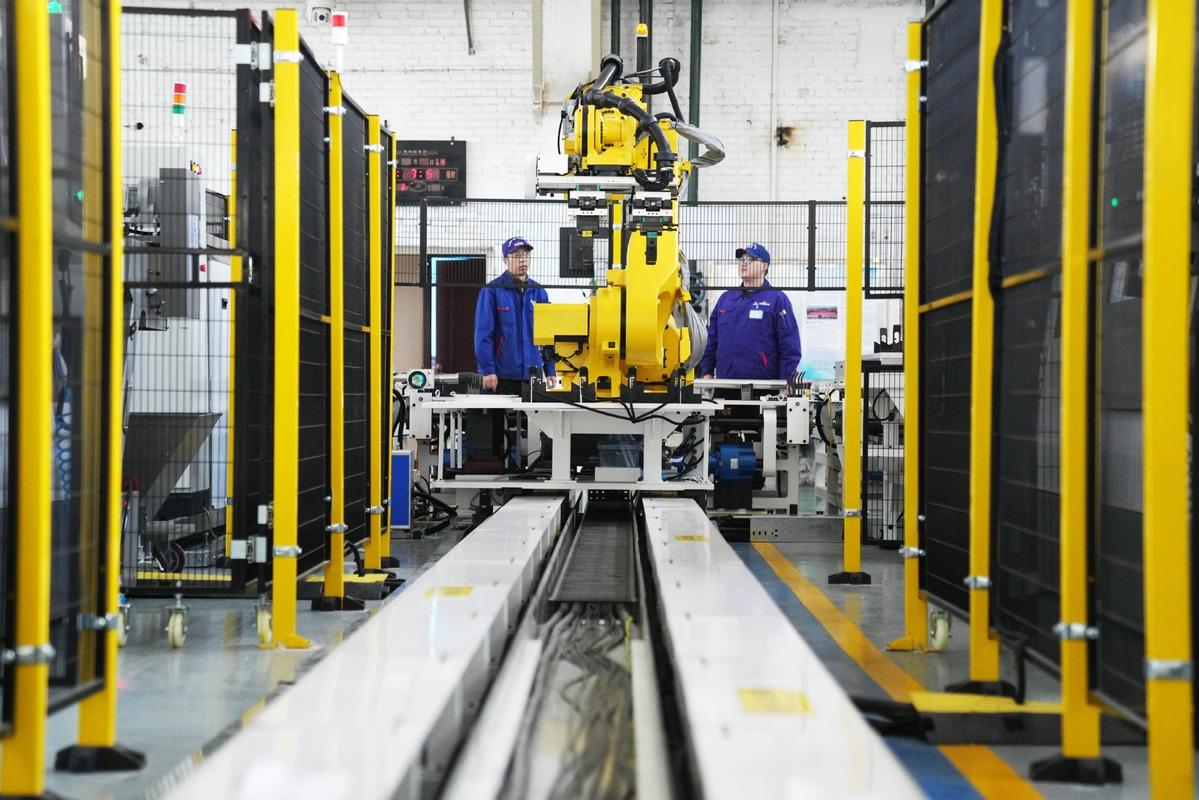China has the fiscal ammunition needed to overcome political and trade obstacles
 Staff members observe the operation of intelligent equipment at a turbine subsidiary of Harbin Electric Corporation in Harbin, Heilongjiang province, on Feb 22, 2024. The Harbin Electric Corporation actively develops emerging industries, future industries, and has built a number of digital workshops, production lines and production units. (PHOTO / XINHUA)
Staff members observe the operation of intelligent equipment at a turbine subsidiary of Harbin Electric Corporation in Harbin, Heilongjiang province, on Feb 22, 2024. The Harbin Electric Corporation actively develops emerging industries, future industries, and has built a number of digital workshops, production lines and production units. (PHOTO / XINHUA)
China's economic goals this year reflect a focus on high-quality growth combined with sensible support for local governments, as the country navigates global political and trade obstacles, US experts said.
When delivering the Government Work Report at the opening meeting of the annual session of the national legislature in Beijing on Tuesday, Premier Li Qiang announced China's 2024 GDP growth target of around 5 percent.
Sourabh Gupta, a senior fellow at the Washington-based Institute for China-America Studies, said 5 percent growth will be harder to achieve because the 2023 growth numbers were somewhat boosted by the lower base of the 2022 numbers, which were affected by the COVID-19 pandemic.
READ MORE: Govt report: China pushes for 5% GDP growth, more jobs
"The economy will need to work hard to get to the 5 percent figure, considering the many headwinds that it is facing," Gupta said, but added, "The government has the fiscal ammunition in store to attain its growth target."
Gupta said he expects manufacturing and infrastructure "to carry the growth load".
On the issuance of 1 trillion yuan ($139 billion) in treasury bonds, Gupta said it shows "the central government's resolve to stand behind a certain degree of investment-led growth in order to hit its growth targets".
On trade, Gupta said that "there will no doubt be a degree of trade conflict which will dim the absolute potential" of China's export of products such as electric vehicles and lithium-ion batteries.
"But the European Union is resolved to manage its trade conflicts with China via rules-bound measures, which means that even if it imposes anti-subsidy and countervailing duties against Chinese goods, the market will remain open up to a point to exports and will certainly remain open to foreign direct investment by Chinese-invested enterprises producing these very goods," he said.
"As for the US, I am not so positive. Washington is not attempting to de-risk its economic relationship with China; it is unfortunately attempting to cleanse or 'de-Sinicize' supply chains and trade linked to China," Gupta said.
"That said, many of the Chinese intermediate goods that go into EVs or solar supply chains are so critical that they will continue to flow to the US market too, even though they might be produced by a Chinese-invested company or joint venture in Vietnam or South Korea."
Gupta said that China's emphasis on technological self-reliance, "even over and above expanding domestic demand, was interesting".
He said it was "interesting to note the extent to which the government remains laser-focused on breaking through the shackles of dependence on foreign core technologies".
"The Chinese economy needs to attain takeoff velocity and reach cruising speed first so that it can earnestly tackle the required structural transformations thereafter," Gupta said.
"A growth environment is the most enabling backdrop to implement transformation. Sustained growth, first; then, structural reform."
Christopher Johnson, president and CEO of China Strategies Group, said the GDP goal was "a relatively ambitious target".
"I think it's ambitious and it's going to be hard to reach, but it's also probably the right policy," Johnson, who is also a senior fellow on Chinese politics at the Asia Society Policy Institute's Center for China Analysis, said at a webinar hosted by the CCA.
He also highlighted China's ongoing commitment to high-quality growth. "High-quality growth is still the center of the speech," he said.
China has put the Ministry of Industry and Information Technology in charge of injecting scientific and technological advances into new manufacturing.
"And that remains the mainstay of the government policy that hasn't changed," Johnson said.
Guonan Ma, a senior fellow on the Chinese economy at the CCA, said China's economic strategy was cautious.
"Beijing appears to have shunned 'bazooka-style' stimulus measures," he said. "This approach makes sense, in my view, for two reasons."
First, Ma said, Beijing ought to use its policy space wisely in the coming years. Second, "in my view, the Chinese economy has been holding up reasonably well in recent months, especially in light of the positive activities during the recent Lunar New Year".
ALSO READ: GDP growth of 5% achievable
According to the Ministry of Culture and Tourism, the eight-day Lunar New Year holiday (Feb 10-17) saw more people go on trips, with domestic tourists spending about 633 billion yuan, up 7.7 percent compared with the pre-pandemic level in 2019.
Ma said what is new this year is that China intends to issue ultra-long special treasury bonds over each of the next several years, starting with the 1 trillion yuan of such bonds this year.
"Apparently, the aim is to leverage the still healthy central government balance sheet to assist the cash-strapped local governments," Ma said.
He called it "a meaningful and practical step to address the local government debt challenges rather than simply kicking the can down the road".
Gary Clyde Hufbauer, a nonresident senior fellow at the Peterson Institute for International Economics, said that 5 percent GDP growth "can be achieved with the right policies".
On exports, Hufbauer said: "Unfortunately, there will be restrictions, especially in the US market but also in Europe. However, China can achieve high export growth in other markets in Asia, Latin America and Africa."
Contact the writers at yifanxu@chinadailyusa.com


